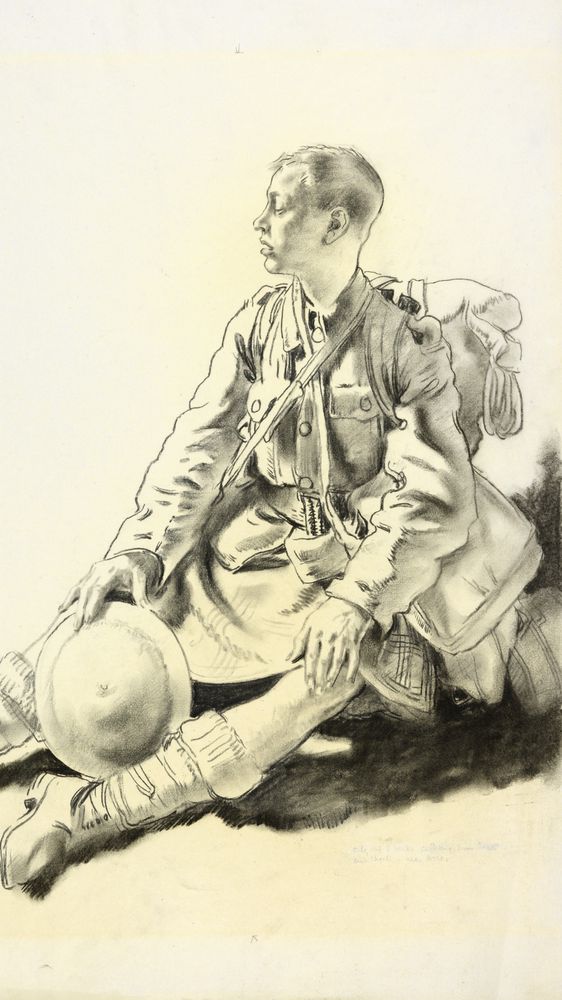Art in the Time of War
All the ways to imagine WWI
Today is Veterans Day, an American holiday that commemorates military veterans of all stripes, from all foreign wars. The holiday was originally called “Armistice Day” because it celebrated the armistice with Germany that marked the end of World War I, an agreement that was finalized on the 11th hour of the 11th day of the 11th month, in 1918. WWI was the last major war before improvements in photography allowed for the mass proliferation of combat images. And so capturing the war was a job left to artists, who were sent to the Western Front from a range of European countries.
Starting last night, we’ve begun filling the feed with playlists featuring art from “The Great War”: Imperial War Museums: Curated Picks, The Art of WWI, and WWI in Color (available in vertical and horizontal). Taken together, these images don’t so much cohere into a single concept of the war, but refract it through many perspectives. This is partly due to the fact the art was produced for a variety of causes—politics or propaganda, editorial or expression. To show the diversity on offer, we’ve put together a short list of some of our most arresting works.
This work by Albin Egger-Lienz, an Austrian painter closely related to German Expressionism, is harrowing. The viewer is being actively approached by nearly identical men, lined up in neat rows. They hold guns as if they are clubs; what comes next feels inevitable. It’s striking because it presents war from the perspective of the soon to be defeated, and in that way it generates empathy. And yet, when we imagine the opposite side, the side of the viewer, what do we expect to see but a mirror image?

- Click to Add to playlist
- Click to Favorite
This Autochrome shows the inherent contradictions of life at wartime. Countries at war are seen as a militaristic force, but they are still countries—full of domesticity, children, life. Seeing the two concepts intermingle provokes dissonance.
William Orpen was one of the most prolific artists Britain sent to the Western Front. This drawing of what must be called a boy is hard to fathom. It’s easy to imagine our soldier living a life outside of war. In his pose we see an unbothered adolescent, passing a lazy Sunday outdoors, taking a rest by a tree.
No set of combat imagery is complete without a showcase of technology. Wartime, after all, is also a time of invention and innovation. This airship hangs in the air impossibly, as if any second it might yield to more realistic physics and plummet to the earth. It is hard to imagine civilians seeing such an object for the first time, hovering over their town like a UFO.
But not all technology produces such beautiful images. It’s not clear what’s going on in this painting by John Singer Sargent—until you look at the title. The men here have been temporarily blinded by mustard gas. A line of them are being led to the hospital while the rest lie on the ground, waiting their turn.

- Click to Add to playlist
- Click to Favorite
For all of the excitement of war, much of it can be uneventful, banal even. Here we see soldiers buying and reading newspapers at a kiosk in Rexpoede, Department Nord, Région Nord-Pas-de-Calais. Their faces are knowing if not a bit mischievous, perhaps emboldened by their relative safety.

- Click to Add to playlist
- Click to Favorite
This painting by John Nash is hard to take in at once. Different regions fight for the viewer’s attention. In the trench we see a man, possibly dead, possibly taking cover. The trench’s steep slope threatens to pull back the men exiting. They advance in various poses, like a monkey-to-man evolution diagram. But the ones furthest along still keep their backs hunched, not unlike zombies.
But of course the most obvious image is one of destruction. Here we see firefighters, military, and civilians trying to prevent fires from spreading after a bombing in Dunkirk. There is carnage, but enough of a foundation left to rebuild—the perfect metaphor for Europe after the war.
This tribute to an anonymous soldier, also painted by Orpen, features a coffin located in the Hall of Peace at the Palace of Versailles. An image of war painted after the fighting is over, it perhaps implies a more optimistic fate for the lives lost at battle; ahead of the veteran we see a long hall leading to an arched opening—light at the end of the tunnel.







